Strength is great. Obviously all climbers want to get stronger, and they should.
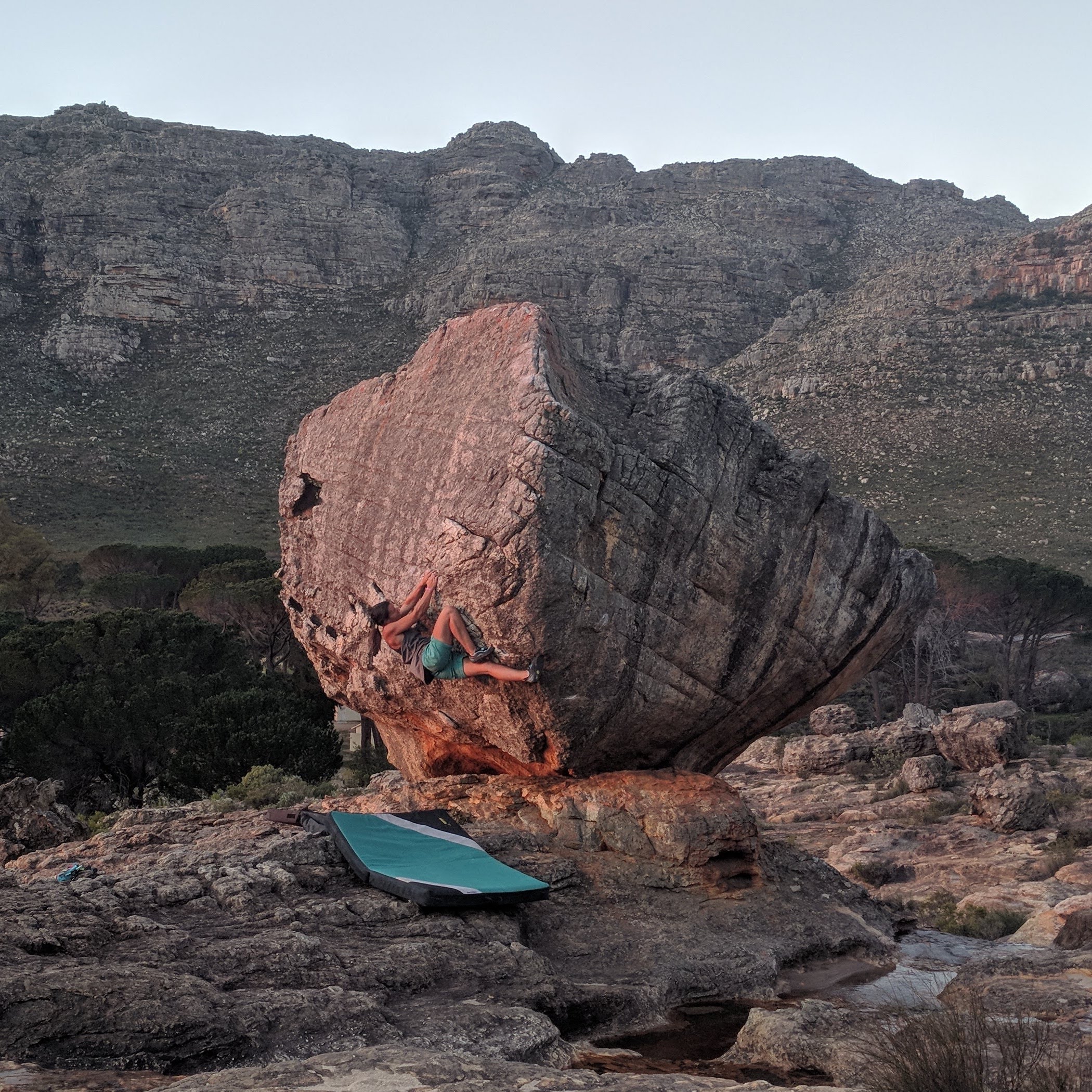
Strong is the word thrown around at the crag when we mean “high performance.” In fact, most of our casual ways of describing high performance involve physicality. “She’s so strong”, “He did it 2nd go, he’s a beast”, “You’d have to be so strong to flash that”, etc. Only once in a great while do we hear of a “wizard” or a “genius.”
In this post I will articulate a way of looking at climbing performance where strength is the peak, rather than the base, of our performance. What I mean by that is that we will look at what other factors influence our climbing performance before we ever get the chance to apply force to the wall.
Strength in the moment
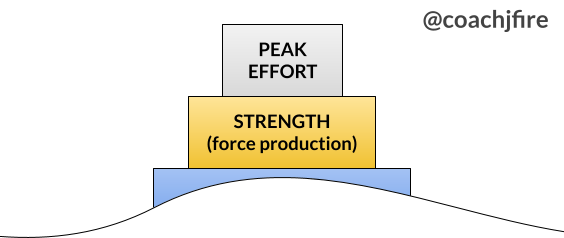
Strength, classically, is how much force you can exert. I would add that for climbers, it’s how much force you can exert given the physical constraints of the challenge. Pulling on a 20mm Tension Block is a lot different than pulling on an edge of varying depth and incut while your body swings in multiple vectors below it. As climbers, this includes a variety of physical factors and traits. For the sake of this post I’m lumping things like velocity and endurance demands into constraints associated with “the moment” when you need peak force production.
There is a bit of a feedback loop between our physical state and other performance traits. Knowing you’re putting up good numbers can have a positive effect on confidence, inspire you to try something you might not have, and just make you feel better about your climbing. Certainly in this sense, being stronger is an all-around crucial element of being a great climber. Each layer of the cake plays into the others.
However, I think when you dissect a peak performance, tons of other elements enter the picture before strength. After all, your force production is zero if you never make it to the boulder. If you don’t find the correct moves, the demand for force production will be vastly higher. And if you’re not focused and present when you need to be, you might not be able to give the same effort that you gave when you were putting up great numbers in the gym.
These are the systems I see influencing a climber’s ability to make use of their strength when the moment comes. These can be placed in different orders depending on the climber and the challenge at hand, but this is how it usually feels for me subjectively. There are a million factors – I surely missed some, and some minutiae fit into multiple categories. Take it as a way to brainstorm potential areas of improvement rather than a codified set of rules.
Obviously many factors go into whether you’re strong enough. A plethora of books and blog posts have been written on that subject. I’m going to skip over those so that this post can remain focused on the non-physical elements: tactics, beta selection, emotional preparedness, logistics, and identity.
Session tactics

In order to give a really good try, we need to be as recovered and prepared as we can be. We also need to be in the right place psychologically for whatever the challenge is.
Our skin & shoes are where we contact the rock. These tiny surface areas are where the work actually gets done. Effort that goes into ensuring they are as prepared as they can be is the next most essential component of success.
Choosing which parts of a climb to work on, understanding where our weak points and gaps are, managing our rest time, and making sure the session is as effective as it can be given time constraints – these are all tactical choices that we need to make in every session.
Tactical factors influencing success / areas of improvement to consider
- Your warm up & rituals for staying ready
- How much to try a given route – rest & work cadence
- When to switch from trying moves to linking to going for the send, if relevant
- When to go back to retrying or rewiring moves if needed
- Which links to try
- (These last 3 could be summed up as “redpoint skills” which includes many other strategic decisions)
- Managing skin
- Managing gear
Beta selection or preparation for onsighting
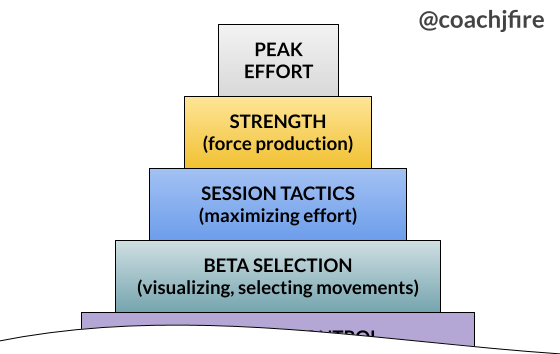
As I mentioned briefly, it doesn’t matter how much force we can produce if we’re producing it on the wrong holds, or in the wrong order, or, for limit efforts, in a way that’s harder than the ideal solution. If you care about getting stronger for climbing, then you must also prioritize your ability to gather, filter, and select beta appropriate for you.
A poem is never finished, merely abandoned.
Paul Valery
I take an endlessly-refining approach to beta selection rather than the find something that might work and smash your head against it until you send approach. Visualizing your sequence and sticking with it is an obvious essential component of limit performance. But leaving room for the humility of being wrong about what’ll work best is equally important. The beta can always be better. Let me repeat that: the beta can always be better. “A poem is never finished; it is merely abandoned.”
For limit flashes, the importance of beta selection holds true. I would argue that for flashes, it’s even more true, since with a flash you only get the one try, period. Gathering as much information from the ground as possible is crucial. A different kind of visualization is useful here, to sort through potential beta and get your own gut check about what’ll work. (In fact, I recommend everyone work on their flash skills – this forced climb-from-the-ground visualization is a huge asset for anyone, and the high stakes of a single try apply well to limit redpointing where energy for attempts is extremely limited.)
For limit onsights, this would be a very small layer if at all. Beta selection is still essential, but must be performed on the fly or in advance using whatever’s visible from a good stance. Same rule applies, though: you can’t exert any force if you don’t choose the right path.
Honorable mention: while flexibility is a physical skill, on a continuum with strength, there’s a strong argument to be made that the point of flexibility is to improve the pool of available beta.
Beta selection factors influencing success / areas of improvement to consider
- Social skills: engaging with other climbers to discuss beta and review efforts
- Rock sense, ability to intuit what the terrain is asking of you
- Beta gathering, ability to see different options
- Beta filtering, reducing the noise and finding the signal
- Beta selection – putting the rest together to decide what to actually try
- Cyclical beta improvement; iterating on what is tried and condensing it into a sequence
Emotional control & sending habit

Some climbers are able to put up consistently good numbers on the hangboard, or can always climb the hardest problem in the gym, but struggle to find a good groove outside. I’m not talking about just not sending a problem; I’m talking about never really looking like the same climber as the one crushing it in the gym.
Our habits and emotional control plays a huge role in our ability to exert force when it counts. Factors outside of your control should be set aside during performance time. Factors inside your control should be dealt with appropriately and maturely. There’s merit to getting emotional energy out, especially if you just punted. But if it goes on for 15 minutes, you’re wasting valuable time you could spend on improving your next attempt.
Basically every route and problem has some degree of risk. Therefore, fear is the most familiar reality in the psychological landscape of climbing. Peak performance requires evaluating the risk of the situation and being prepared to experience fear or uncertainty. If you’re focusing on your fear, you are almost certainly not applying your strength to the wall.
If we can build a “sending habit” in a variety of situations, over time we train ourselves to manage our emotions intuitively.
This can become rote, especially for elite climbers; but don’t mistake that for thinking that it’s not important. Elite climbers have gathered an enormous number of sub-limit and limit efforts where they had to deal with their emotions. Much like physical strength, it’s easier to keep it than to gain it. This ability to drop into “send mode” on command is something commonly witnessed with professional climbers and often conspicuously absent when climbers are operating in new conditions (like the gym crusher mentioned above.) If we can build this sending habit in a variety of situations, over time we train ourselves to manage our emotions intuitively. There are tools for this like mantras, power words, breathing exercises, and more.
Emotional factors influencing success / areas of improvement to consider
- Ability to focus on the task at hand
- Ability to drop into “send mode”
- Ability to manage emotions off the wall like anxiety, anger, stress, and sadness
- Self-talk habits
- Tools like breathing exercises and mantras
- Ability to manage emotions on the wall like fear, overexcitement, confusion
- Deliberate management of psychological arousal level like gearing up for a dyno vs resting before a slippery slab section
Logistics & life circumstances
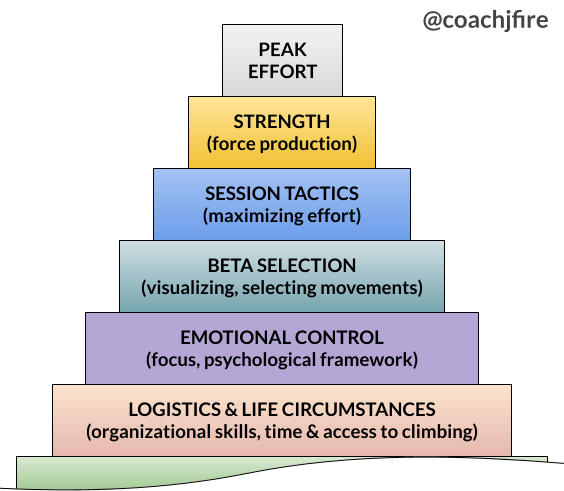
It’s tough to be in the perfect emotional state for hard climbing if you’re going through something intense in your life. It could be positive like getting married, or negative like a death in the family. Regardless, even a climber with superb emotional control might struggle in that situation. (Although – there is a lot to be said for the catharsis of climbing as something stable in the chaos.)
In this layer I would also put effective goal-setting and cycling of performance modes through the year. Being able to produce a ton of force is a lot more useful if you pick projects that are motivating for you, practical to try, and challenging for you but not impossible. Likewise, planning your year well and not trying to stay in performance mode endlessly are important to make sure that you’re well-rested when the time comes to show what you can do.
Climbing alone is wonderful, and I think it can benefit everyone to practice it occasionally. However, there are social factors – very few peak performances happen with the climber alone. Sport climbers need to constantly form and strengthen relationships with other climbers to improve their chances of having climbing opportunities. Bouldering is also inherently social, and you will often have a better chance of sending your project if you feel safe with the pads you have, and you’re not blasted from making multiple trips with multiple pads yourself.
Having the schedule to spend time climbing rocks, and having rocks nearby enough to climb, is also a huge logistical hurdle for many climbers. Having a smaller window to find success puts that much more pressure on the elements leading to performance other than strength, and the timing of that strength becomes more important. Privilege certainly plays a role in this, and is often overlooked as a huge determinant of potential elite performance.
Logistical factors influencing success / areas of improvement to consider
- Time management, both outside of climbing and during climbing sessions
- Ability to practically and effectively pick projects, build a base, and put together a season
- Organizational / logistical skills
- At least cursory knowledge of exercise science
- Social skills and aptitude
- Access to climbing and time for it
- Ability / willingness to change your life circumstances (moving, changing jobs, rebuilding relationships)
Identity & the story of you
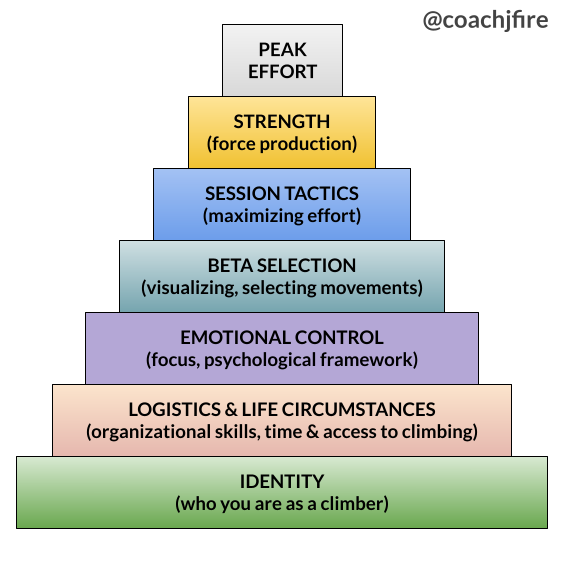
Underpinning everything else in this list is how you got to where you are. Who are you as a climber? Why are you trying the project you’re trying? How do you identify with it? How will this challenge change you as a climber, and is that the direction you want to go?
I put this at the base because I believe all the other layers are intimately affected by your identity. Putting your whole self into your athletic endeavors is essential for all the other pieces to fall into place. Logistics and ambitious goal-setting is hard to enjoy for many people. If you’re internally convinced that you’re weak or afraid, you will prove yourself right. The time investment of deliberate practice is huge. And strength training, while probably more enjoyable in its own right, is a huge endeavor. These are just examples of how a willingness to adapt and change is essential in order to overcome obstacles to higher performance.
I don’t believe you can truly give all of yourself to an effort if you don’t identify with it. The best hangboard numbers in the world won’t hold you on the wall if you aren’t convinced that you can do it, or if you sabotage yourself from ever getting to try.
When the chips are down, one who considers climbing a core part of their identity will find a way to make it work.
There is merit to having a multifaceted identity, and I would never suggest that someone ignore the rest of their life outside climbing. Make no mistake, your life outside of climbing plays a huge role in your performance. Often lining everything up for the big send means juggling or back-burnering a dozen other stresses. When the chips are down, one who considers climbing a core part of their identity will find a way to make it work.
Identity-based factors influencing success / areas of improvement to consider
- Ability to see clearly who you are, and who you want to be
- Willingness to make life changes and sacrifices (may change who you are)
- Readiness to accept things that cannot be changed about your life and their impact on your climbing (may change who you want to be)
- Acceptance of the vulnerability of commitment
Strength comes at the end
Once we’re actually under our project, pulling on for the attempt – that’s the moment that strength really enters the picture. There are so many other factors leading up to that moment, and all of them are trainable. But don’t try to rewrite the entire book of your climbing in one day. Tune out the noise, pick one or two things at a time to focus on, and do the work.
We should pay attention to the way we talk about ourselves as climbers. Our self-talk says a lot about what’s actually holding us back from performing our best.
The first and most important takeaway should be this: We should pay attention to the way we talk about ourselves as climbers. Our self-talk says a lot about what’s actually holding us back from performing our best. Often, hiding behind strength – whether as an advantage or a weakness – is a way of coping with the fact that something else, something harder to quantify, is the real obstacle between us and our success.
It’s not easy to get a few percent stronger year after year. But it’s easier than the uncomfortable work of toning down our aggression, or accepting that we’re scared, or acknowledging that our self-talk is destructive to our success, or bucking up and identifying with that big goal even though we might fail, or deciding to pick up and move somewhere with more climbing opportunities.
Great climbers will do both: chip away at their strength year after year, with their eyes on the horizon – but also look in the mirror, examine their habits closely, and do the hard work of self-improvement.